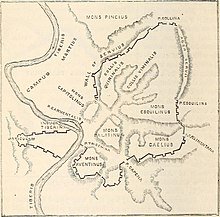Porta Fontinalis
[3] During a highly active period of building construction and religious dedications following the Second Punic War, the aediles of 193 BC, Marcus Aemilius Lepidus and Lucius Aemilius Paullus, built a monumental portico linking the Porta Fontinalis to the Altar of Mars in the Campus Martius.
[4] The portico, known as the Aemiliana, was a covered walkway for the censors, who conducted the census at the Altar of Mars but had their office just inside the gate, within the walls.
[6] A funerary stele of the 2nd century AD preserves the name of a shoemaker, Gaius Julius Helius, who was located somewhere around the gate.
[7] Most notoriously, Gnaeus Calpurnius Piso, the supposed poisoner of the Emperor Tiberius' heir apparent Germanicus, had built structures above the gate to connect his private residences.
As part of the punitive measures against the associates, family, and memory of Piso in the wake of the conspiracy, the senate ordered the demolition of these structures.
